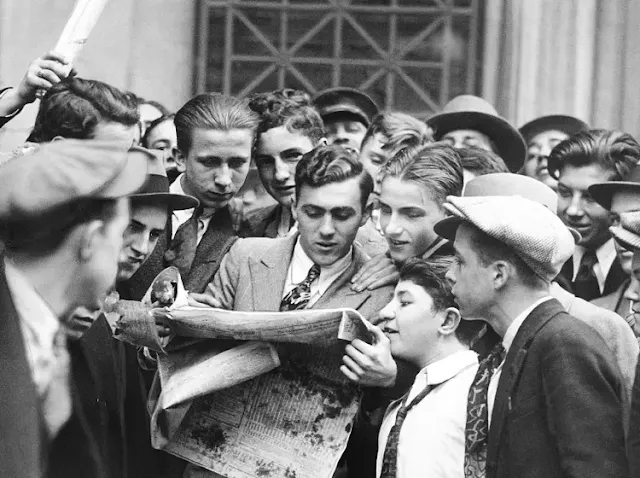The Black Tuesday Catastrophe: An In-Depth Study of the 1929 Stock Market Crash and Its Devastating Impact on the Global Economy
The stock market crash of October 1929, known as "Black Tuesday," marked a critical turning point in global economic history. This event was not just a temporary collapse of financial markets but the beginning of a decade-long Great Depression, which left deep scars on the economic and social fabric of developed countries and had repercussions that spread across the globe. On October 29, 1929, the New York Stock Exchange alone witnessed 16 million shares traded in a single day, recording catastrophic losses of billions of dollars and wiping out immense fortunes in the blink of an eye.
Factors Contributing to the Economic Disaster
The 1929 crash did not arise out of nowhere. It was the result of an accumulation of interconnected factors that collectively fed the stock market bubble and led to its dramatic collapse. These factors include:
- Accumulated Debt: The 1920s witnessed tremendous economic growth in the United States, but this growth was accompanied by a rapid increase in consumer borrowing. Many citizens resorted to purchasing consumer goods on installment plans, especially cars and electrical appliances, leading to an alarming rise in debt levels.
- Unequal Wealth Distribution: While the 1920s saw widespread economic prosperity, the wealth was not distributed evenly. The benefits of economic growth were concentrated in the hands of a small minority, while the majority of the population continued to struggle with low wages and rising prices. This stark disparity created a significant imbalance in the U.S. economic structure.
- Agricultural Overproduction: The American agricultural sector faced severe difficulties during this period due to overproduction and declining demand. Farmers suffered from falling prices for agricultural products, leading to mounting debts and the loss of lands and properties for many.
- Lenient Monetary Policies: Some analyses attribute part of the disaster to financial institutions and central banks, accusing them of leniency in granting loans and encouraging speculation in the stock market. This, in turn, led to an uncontrolled increase in the money supply, exacerbating the bubble's inflation.
- Lack of Stock Market Regulation: The stock market was devoid of rules and regulations, facilitating speculation and risk-taking, which contributed to the creation of an unsustainable price bubble. Financial reports were not subject to adequate scrutiny, and market information was often vague and contradictory, increasing the risks associated with trading on the New York Stock Exchange.
The Stock Market Bubble and the Collapse: The Beginning of the End
During the 1920s, stock prices experienced unprecedented growth, making investment in the stock market highly profitable regardless of the actual value of the stocks or the future of the companies. This surge in prices created an inflationary bubble that kept growing until it eventually burst.
This bubble was not accidental. The media played a role in reinforcing this situation by highlighting quick wealth opportunities in an overly positive light, increasing the number of investors and amplifying the volume of purchases.
Black Tuesday: The Catastrophe That Changed the World
October 29, 1929, "Black Tuesday," marked the turning point in the story. This day witnessed widespread panic, prompting investors to sell their shares at any price, regardless of their actual value. Stock prices plummeted sharply, destroying fortunes and causing massive losses. Many companies halted operations, and trust in the American and global economy vanished.
The stock market crash had a domino effect on the global economy, leading to:
- Bank Failures: Many depositors withdrew their money out of fear, causing numerous banks to go bankrupt.
- Rising Unemployment Rates: Demand plummeted, and numerous factories and companies ceased operations, dramatically increasing unemployment rates. Unemployment in the U.S. reached 25%, the highest in its history.
- Decreased Consumption: Consumer demand dropped significantly, impoverishing society and causing many economic projects to be abandoned.
- Global Trade Decline: The crash negatively affected global trade, with exports and imports shrinking. Economic transactions became sparse, and many workers went on strike due to dire economic conditions.
- Mass Migration in Search of Hope: Many families were forced to migrate to other areas in search of job opportunities.
Major Transformations After the Crash: Lessons Learned
The 1929 disaster led to the adoption of numerous new policies aimed at preventing the recurrence of a similar economic catastrophe.
We witnessed financial reforms in stock exchange regulations to make them more transparent and secure, as well as enhanced global regulatory authority.
Additionally, the introduction of the "New Deal", which included massive projects to revive the economy and create job opportunities, marked a significant change.
Conclusion: An Unforgettable Lesson from History
The 1929 stock market crash serves as a valuable lesson in how economic crises develop and how they can spread to topple even the strongest global economies. Managing debt, distributing wealth fairly, and controlling market bubbles remain crucial to avoiding future catastrophic economic collapses. This event serves as a constant warning to policymakers, economists, and anyone involved in investment in all its forms.



.webp)

.webp)